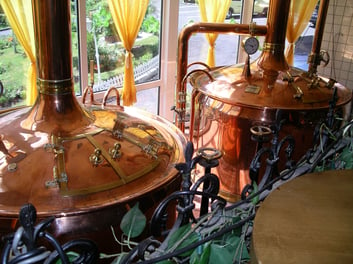Process Control
Process control systems are used in everything from advanced manufacturing to run-of-the-mill activities at home, like heating your house and brewing your beer. (You do brew your own beer, don't you?)
A control system that manufactures a product requires monitoring and control of many different process variables, while some at home require little more than a timer. For example, in manufacturing we may use flow meters to make sure fluids flow through pipes at a certain rate, or float meters to ensure ingredients fill a vat to a specified level.
When I brew beer at home, I may use a temperature sensor in my mash tun, wired to a controller that’s controlling my heating element to keep the mash tun at just the right temperature for optimum starch-to-sugar conversion. This is an example of a closed-loop control system.
(To see how small closed-loop control principles are scaled up to build industrial process control applications, check out the New Belgium Brewery case study and see how they use Opto 22 gear to brew their world-famous Fat Tire and other beers.)
On the other hand, if you look at how a basic clothes dryer operates, it uses an open-loop control system. When you put your wet laundry into the dryer and start its drying cycle, it uses a single setpoint in the form of an internal timer to determine when to turn off your dryer. Throw the wet clothes in, turn the dial, and after an hour or so your dryer automatically shuts off, whether the clothes are dry or not.
 To produce a finished product of repeatable quality and consistency, you have to combine many individual processes and run them simultaneously. In manufacturing and industrial automation, each process must be precisely controlled by some type of automatic controller.
To produce a finished product of repeatable quality and consistency, you have to combine many individual processes and run them simultaneously. In manufacturing and industrial automation, each process must be precisely controlled by some type of automatic controller.
For example, an Opto 22 SNAP PAC controller.
Open-Loop Control
So process control is performed automatically to help ensure consistent and repeatable results. If a process is controlled only by setpoint commands without any feedback measurement signals, the system is referred to as open loop.
Open-loop control is used in applications with simple processes. Timing functions and setpoints typically control the operation. We find open-control systems in industrial dishwashers, laundry machines, and printed circuit board burn-in chambers. These types of equipment are often manually configured and set to run.
The advantage to open-loop systems is that they’re typically pretty cheap, because there’s less computing power built into them. The major drawback, however, is that without a feedback loop, there's no way to change output states if the process deviates from its required state. For that, we need to use closed-loop control.
Closed-Loop Control
For more advanced automation and process control applications, we turn to closed-loop control. In closed-loop control we add some form of a feedback loop, which is attached to a process controller. The feedback loop provides information on the status of the process to the process controller, which then adjusts the process to become self regulating.
For example, in our beer brewing application above, we need to keep the temperature of the mash tun just right for optimum starch-to-sugar conversion. During this conversion, external variables work against our attempt to control the process. For example, the temperature in the room may fluctuate, or ingredients added to the mash tun may change the mash tun water temperature.
 To control the process, we need to use a feedback loop.
To control the process, we need to use a feedback loop.
For example, we may add a temperature sensor in the mash tun and wire it to an input module, which sends data to a process controller like a SNAP-PAC-R1. We could then wire the heating element to an output module controlled by the SNAP-PAC-R1.
That way, when the temperature in the mash tun is out of the desired setpoint, the controller can output a value to the mash tun heating element and bring the process back into the desired temperature setting.
Several different types of controllers can be used for process control. For a great article that compares the different types of technologies available today, check out Food Engineering’s article "PLCs and PACs: Know when and where to use them."
SNAP PAC controllers are programmed to perform an operation using a human-readable, visual flowchart programming language. This easy-to-understand language makes building an industrial automation application pretty simple, even for someone with little to no industrial automation or process control experience.
Interested in adding a temperature feedback loop to your process? Download the temperature sensor primer.

